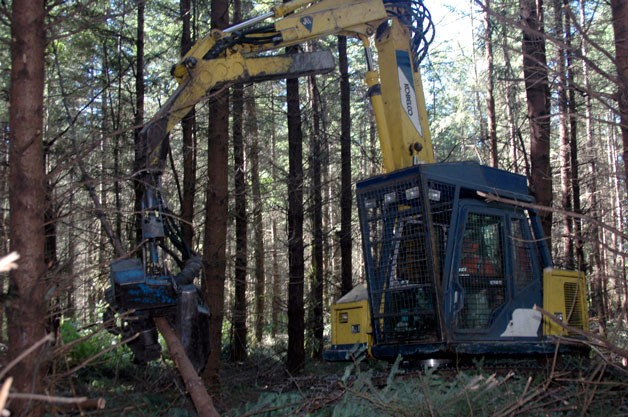TULALIP — For the Tulalip Tribes, it’s a means of maintaining not only their lands, but also their culture.
Precision Thinning began grooming 88 acres of two 28-year-old stands of Douglas fir trees on the Tulalip Tribes reservation in late June, thinning them from an average of 400 down to 160 trees per acre. The Tribes aim not only to foster healthier trees and a richer ecosystem, but also to provide their peoples with places to forage and hunt, which are important parts of their heritage.
“By taking out smaller competing trees, you leave more room for larger trees that will yield higher value down the line,” Tulalip Tribes Forester Russell Moses said, before showing two segments of tree trunks, both 20 years old, to compare the size of trees in thinned versus non-thinned stands. The trunk segment from the thinned stand was much thicker.
“You get better quality trees,” Tulalip Tribes Forestry Technician Ross Fenton agreed, as he noted that thinning also reduces the risk of forest fires over the long term. “The loggers we’ve talked to have said that wildlife has already started to move right into the thinned stands.”
Precision Thinning’s co-owners, Roger Melton and Brian Aungst, conduct the thinning themselves with a processor and a forwarder, two machines that cut the trees down to logs and move them out of the stands without damaging the forest floor. Tulalip Tribes spokesperson Francesca Hillery noted that the shared goal of the company and the Tribes is to minimize the impact on the forest floor which the company also does with weight-distributing tires.
Tulalip Tribes Wildlife Manager Mike Sevigny explained that the stand near the reservation’s Fire Trail Road would be cleared out around next year for a planting similar to the one in its Middle Meadow property which was planted in the fall of 2009. He cited the variety of species that have been placed in those areas and have been spotted in increasing numbers over time, both by visitors to those sites and by on-site tracking cameras.
“With a closed canopy it was sterile with not a lot of undergrowth,” said Sevigny, who reported populations of deer, turkeys, grouse and other birds and mammals in those areas. “When sunlight hits the forest floor, you get more shrubs and herbs for animals to subsist on. We’ve even spotted does with fawns. This gives a higher survival rate to their young.”
Sevigny acknowledged that forest stands tend to thin themselves naturally over the course of hundreds of years, but cited Tribal thinning efforts as a way of avoiding what he deemed the “boom-and-bust cycle” of natural thinning. Tulalip Tribes Wildlife Biologist Jason Schilling added that this thinning not only increases the numbers of game and non-game animal species alike, but has also fostered traditional Tribal plant gathering species in those areas, to provide for both hunters and foragers.
“We lost a lot of our traditions and our territory, so it’s important to take care of what we have to pass it on to future generations,” Tulalip Tribes Rediscovery Coordinator Inez Bill said. “When we harvest, we don’t take everything from an area, but we take little bits. We do it with respect, according to our values. We offer classes to our community so we can show them and teach them and share the stories that set us apart. If you don’t take care of a gift, you’ll lose it.”



